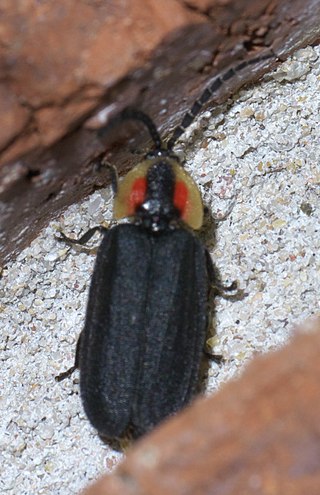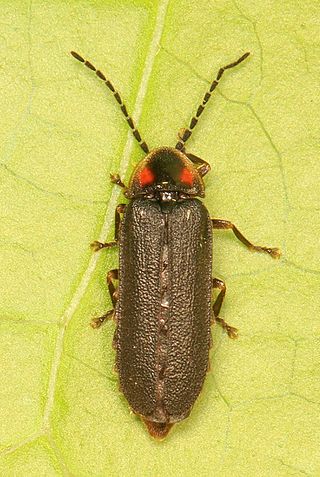
Pinus clausa is a species of pine endemic to the Southeastern United States. Its common names include sand pine, Florida spruce pine, and scrub pine.

Ceratiola is a genus of flowering plants with a single species, Ceratiola ericoides, a shrub endemic to the Southeastern United States.

The island scrub jay, also known as the island jay or Santa Cruz jay, is a bird in the genus, Aphelocoma, which is endemic to Santa Cruz Island off the coast of Southern California. Of the over 500 breeding bird species in the continental U.S. and Canada, it is the only insular endemic landbird species.

The Lake Wales Ridge State Forest is in the U.S. state of Florida. The 26,563-acre (107 km2) forest is located on the Lake Wales Ridge in Central Florida, within Polk County near Frostproof.

Florida scrub is a forest ecoregion found throughout Florida in the United States. It is found on coastal and inland sand ridges and is characterized by an evergreen xeromorphic plant community dominated by shrubs and dwarf oaks. Because the low-nutrient sandy soils do not retain moisture, the ecosystem is effectively an arid one. Wildfires infrequently occur in the Florida scrub. Most of the annual rainfall falls in summer.

The gopher frog is a species of frog in the family Ranidae, endemic to the south-eastern United States. It primarily inhabits the threatened sandhill communities, flatwoods, and scrub in the Atlantic coastal plain, where it is usually found near ponds.
The Caribbean bioregion is a biogeographic region that includes the islands of the Caribbean Sea and nearby Atlantic islands, which share a fauna, flora and mycobiota distinct from surrounding bioregions.

The Florida scrub jay is one of the species of scrub jay native to North America. It is the only species of bird endemic to the U.S. state of Florida and one of only 15 species endemic to the continental United States. Because of this, it is keenly sought by birders. It is known to have been present in Florida as a distinct species for at least 2 million years, and is possibly derived from the ancestors of Woodhouse's scrub jay.

Hypericum cumulicola is a rare species of flowering plant in the family Hypericaceae known by the common name highlands scrub hypericum, or highlands scrub St. John's wort. It is endemic to Florida, where it is threatened by habitat loss and degradation. It is a federally listed endangered species of the United States.
Melanoplus forcipatus is a species of grasshopper in the subfamily Melanoplinae, in the family Acrididae. The species is known generally as the "toothcercus shortwing grasshopper" or "broad cercus scrub grasshopper". It is endemic to scrub and sandhill communities in Highlands and Orange counties in Florida.
Schistocerca ceratiola, the rosemary grasshopper, is a species of bird grasshopper in the family Acrididae. It is endemic to the Florida scrub in Florida.

Lucidota is a genus of fireflies in the beetle family Lampyridae. There are more than 160 described species in Lucidota.
Geolycosa xera, or Mccrone's burrowing wolf spider, is a species of wolf spider (Lycosidae) endemic to Florida in the United States.
Melanoplus tequestae, known generally as the tequestae scrub grasshopper or tequesta grasshopper, is a species of spur-throated grasshopper in the family Acrididae. It is endemic to Florida scrubs in Highlands, Orange, and Seminole counties in Florida.
Melanoplus indicifer, known generally as the spinecercus short-wing grasshopper or east coast scrub grasshopper, is a species of spur-throated grasshopper in the family Acrididae. It is endemic to Florida scrubs on the Atlantic Coastal Ridge in Palm Beach County, Florida, United States.
Neotridactylus archboldi, the Archbold pygmy mole cricket, or scrub pygmy mole cricket, is a species of pygmy mole cricket in the family Tridactylidae. It is endemic to Florida, where it is found in Florida scrub on the Lake Wales Ridge.

Lucidota punctata is a species of firefly in the beetle family Lampyridae. It is found in North America.
Eusattodera is a genus of skeletonizing leaf beetles in the family Chrysomelidae. There are about six described species in Eusattodera. They are found in North America.
Peltotrupes youngi, known generally as Young's deep digger scarab, is a species of earth-boring scarab beetle in the family Geotrupidae. Other common names include the ocala burrowing scarab and ocala deep digger scarab beetle. It is endemic to Florida scrubs in Marion and Putnam counties in Florida.

Osmia calaminthae, commonly known as the blue calamintha bee, is a rare species of mason bee known only from two small areas in Florida, United States. It is considered Critically Imperiled by NatureServe. The common name for the bee is derived from its distinctly blue color and its favored host plant, Calamintha ashei.










